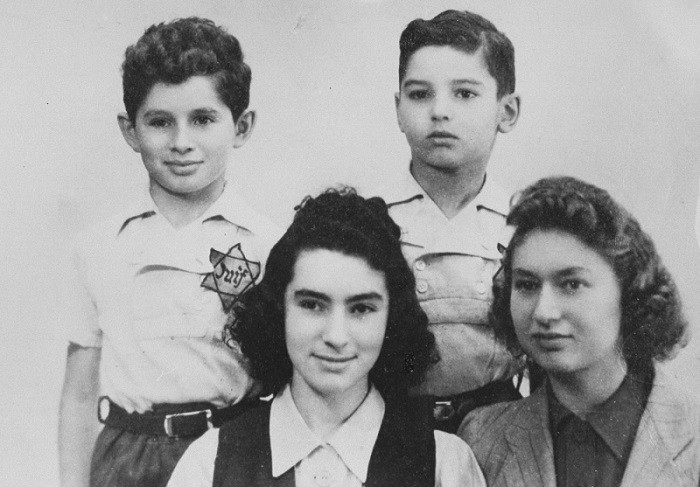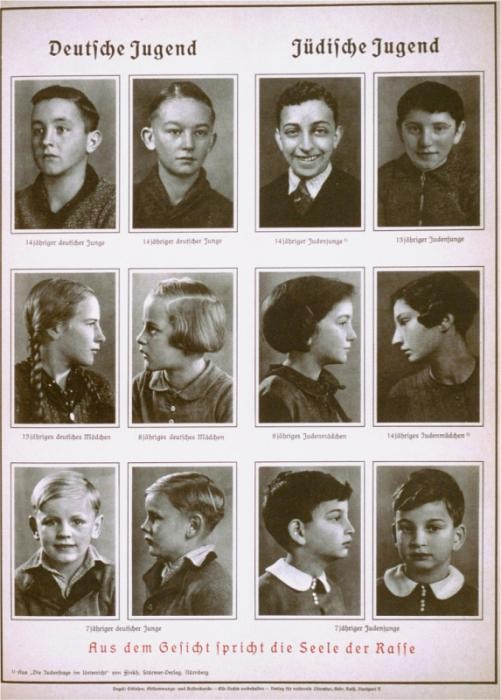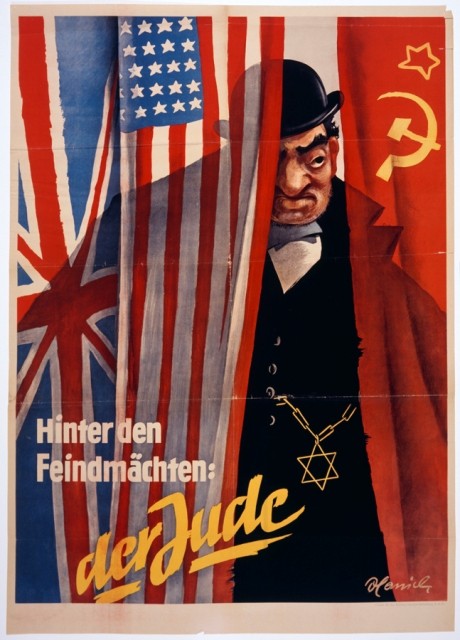
Victims of the Nazi Era: Nazi Racial Ideology
The Holocaust
The Holocaust is an event central to our understanding of western civilization, the nation state, modern bureaucratic society, and human nature. It was the premeditated mass murder of millions of innocent civilians. Driven by a racist ideology that regarded Jews as “parasitic vermin” worthy only of eradication, the Nazis implemented genocide on an unprecedented scale. They slated all of Europe's Jews for destruction: the sick and the healthy, the rich and the poor, the religiously orthodox and converts to Christianity, the aged and the young, even infants.

About two out of every three Jews living in Europe before the war were killed in the Holocaust. When World War II ended in 1945, six million European Jews were dead; more than one million of the victims were children. Even this statistic is misleading, because most of those who survived resided in areas of Europe not occupied by Germany during the war: eastern areas of the Soviet Union, Great Britain, Bulgaria, and neutral states like Spain, Portugal, Switzerland, and Sweden. Tens of thousands of Jews also survived in German-occupied Europe mostly in hiding or as prisoners in concentration camps until liberation. The Germans and their collaborators were relentless in hunting down and killing Jews in the areas of Europe that they controlled.
Much has been written about what took place during the era of the Holocaust and where, when, and how the Nazis carried out their murderous plans. To begin to comprehend the Nazis' actions, however, one must first consider and understand the theoretical underpinnings that led them to conceive of such plans in the first place. Examining the Nazi ideology of race partly explains this relentless commitment to the physical annihilation of the European Jews.
The Nazi Ideology of Race

Adolf Hitler, the Führer (Leader) of the Nazi Party, formulated and articulated the ideas that came to be known as Nazi ideology. He thought of himself as a deep and profound thinker, convinced that he had found the key to understanding an extraordinarily complex world.
Hitler believed that a person's characteristics, attitudes, abilities, and behavior were determined by his or her so-called racial make-up. In Hitler's view, all groups, races, or peoples (he used those terms interchangeably) carried within them traits that were passed from one generation to the next. No individual could overcome the qualities of race. All of human history could be explained in terms of racial struggle.
In formulating their ideology of race, Hitler and the Nazis drew upon the ideas of the German social Darwinists of the late 19th century. Like the social Darwinists before them, the Nazis believed that human beings could be classified collectively as “races,” with each race bearing distinctive characteristics that had been passed on genetically since the first appearance of humans in prehistoric times. These inherited characteristics related not only to outward appearance and physical structure, but also shaped internal mental life, ways of thinking, creative and organizational abilities, intelligence, taste and appreciation of culture, physical strength, and military prowess.
The Nazis also adopted the social Darwinist take on Darwinian evolutionary theory regarding the “survival of the fittest.” For the Nazis, survival of a race depended upon its ability to reproduce and multiply, its accumulation of land to support and feed that expanding population, and its vigilance in maintaining the purity of its gene pool, thus preserving the unique “racial” characteristics with which “nature” had equipped it for success in the struggle to survive. Since each “race” sought to expand, and since the space on the earth was finite, the struggle for survival resulted “naturally” in violent conquest and military confrontation. Hence, war—even constant war—was a part of nature, a part of the human condition.
To define a race, the social Darwinists affixed stereotypes, both positive and negative, of ethnic group appearance, behavior, and culture. These stereotypes were allegedly unchangeable and rooted in biological inheritance. They remained unchanged over time and were immune to changes in environment, intellectual development, or socialization. For the Nazis, assimilation of a member of one race into another culture or ethnic group was impossible because the original inherited traits could not change: they could only degenerate through so-called race-mixing.
Targeted Groups

The Nazis defined Jews as a “race.” Regarding the Jewish religion as irrelevant, the Nazis attributed a wide variety of negative stereotypes about Jews and “Jewish” behavior to an unchanging biologically determined heritage that drove the “Jewish race,” like other races, to struggle to survive by expansion at the expense of other races.
While it classified Jews as the priority “enemy,” the Nazi ideological concept of race targeted other groups for persecution, imprisonment, and annihilation. These groups included Roma (Gypsies), people with disabilities, Poles, Soviet prisoners of war, and Black People in Germany. The Nazis also identified political dissidents, Jehovah’s Witnesses, homosexuals, and so-called asocials as enemies and security risks either because they consciously opposed the Nazi regime or some aspect of their behavior did not fit Nazi perceptions of social norms. They sought to eliminate domestic non-conformists and so-called racial threats through a perpetual self-purge of German society.
The Nazis believed that superior races had not just the right but the obligation to subdue and even exterminate inferior ones. They believed that this struggle of races was consistent with the law of nature. The Nazis pursued a strategic vision of a dominant German race ruling subject peoples, especially the Slavs and the so-called Asiatics (by which they meant the peoples of Soviet Central Asia and the Muslim populations of the Caucasus region), whom they judged to be innately inferior. For purposes of propaganda, the Nazis often framed this strategic vision in terms of a crusade to save western civilization from these “eastern” or “Asiatic” barbarians and their Jewish leaders and organizers.
The Racially Defined Collective

For Hitler and other leaders of the Nazi movement, the ultimate value of a human being lay not in his or her individuality, but in his or her membership in a racially defined collective group. The ultimate purpose of a racial collective was to ensure its own survival. Most people would agree that humans have an individual instinct for survival, but Hitler went on to assume a collective instinct for survival centered on membership in a group, a people, or a race (using these terms interchangeably). For the Nazis, this collective instinct for survival always involved safeguarding the purity of the “race” and the struggle with competing “races” for territory.
Maintaining race purity was important, according to Hitler and others, because mixing with other races would over time lead to bastardization and degeneration of a race to the point where it lost its distinguishing characteristics and, in effect, lost the capacity to effectively defend itself, thus becoming doomed to extinction. Territory was vital, Hitler insisted, because the expanding population of a race required it. Without new territory to support an expanding population, Hitler believed the race would ultimately stagnate and face eventual disappearance.
Nazi racial ideology also included the idea of a qualitative hierarchy of races, in which not all races were equal. Hitler believed that Germans were members of a superior group of races that he called “Aryan.” The German “Aryan” race was gifted above all other races, Hitler asserted, with this biological superiority destining the Germans to rule a vast empire across Eastern Europe.
The "Aryan" Race

But, Hitler warned, the German “Aryan” race was threatened by dissolution from within and without. The internal threat lurked in intermarriages between “Aryan” Germans and members of inherently inferior races: Jews, Roma, Africans, and Slavs. The offspring of these marriages were said to dilute the superior characteristics reflected in German blood, thus weakening the race in its struggle against other races for survival.
The interwar German state further weakened the German “Aryan” race by tolerating procreation among people whom the Nazis considered genetically degenerate and a harmful influence on the hygiene of the race as a whole: people with physical and mental disabilities, habitual or career criminals, and persons who compulsively engaged in socially “deviant behavior” as the Nazis perceived it, including homeless people, allegedly promiscuous women, people unable to hold a job, or alcoholics, among others.
The German “Aryan” race was also threatened with dissolution from without, because, according to Hitler, the Weimar Republic was losing the competition for land and population to the “inferior” Slavic and Asiatic races. In this competition, the “Jewish race” had refined its traditional Socialist tool—Soviet communism—to mobilize the otherwise incapable Slavs and to deceive Germans into thinking that the artificial device of class conflict overrode the natural instinct of racial struggle. Hitler believed that the lack of living space suppressed the birthrate among Germans to dangerously low levels. To make matters worse, Germany had lost World War I and had been forced by the Treaty of Versailles to give up thousands of miles of valuable land to its neighbors.
To survive, Hitler contended, Germany must break the encirclement of the country by its enemies and conquer vast territories in the east from the Slavs. The conquest of the east would provide Germany with the space required to vastly expand its population, with the resources to feed that population, and with the means to realize the biological destiny of being a master race with the appropriate status of a world power.
Elimination of Racial Enemies

Hitler and the Nazi Party outlined their racial enemies in clear and unequivocal terms. For Hitler and the Nazis, the Jews represented a priority enemy both within and outside Germany. Their allegedly racial and inferior genetic makeup spawned the exploitative systems of capitalism and communism. In their drive to expand, the Jews promoted and used these systems of government and state organization, including constitutions, proclamations of equal rights, and international peace, to undermine the race-consciousness of superior races like the German race. They diluted superior blood through assimilation and intermarriage.
The Nazis claimed that Jews used tools which were under their control or subject to their manipulation to advance their biologically driven expansion to world power. Among these tools were, allegedly, the media, parliamentary democracy along with its focus on individual rights, and international organizations dedicated to peaceful reconciliation of national conflicts. If Germany did not act decisively against the Jews both at home and abroad, Hitler claimed, hordes of subhuman, uncivilized Slavs and Asiatics that the Jews could mobilize would sweep away the “Aryan” German race.
For Hitler, government intervention to segregate the races, to promote the reproduction of those with the “best” characteristics, to prevent the reproduction of those with inferior characteristics, and to prepare for wars of expansion brought the German nation in line with its natural, biologically determined instinct to survive. In addition it fostered a “natural” race consciousness among the German people, a consciousness that the Jews sought to suppress through parliamentary democracy, international agreements on cooperation, and class conflict. By virtue of their racial superiority, Germans had the right and the duty, Hitler believed, to seize territory in the east from Slavs, “Asiatics,” and their Jewish puppet masters. By pursuing these aims, Hitler insisted, Germans followed their own natural instincts. To defeat and dominate the Slavs permanently, the German masters had to annihilate the leadership classes of the region and the Jews, who were the only “race” capable of organizing the inferior races through a brutalizing Bolshevik-Communist doctrine that was a biologically fixed “Jewish” ideology.
The Nazis believed that eliminating this "threat" to German survival meant eliminating the people who were labeled by racial ideology as the standard-bearers of that threat. Hitler believed that this was the way nature worked. In the end, Hitler's program of war and genocide stemmed from what he saw as an equation: "Aryan" Germans would have to expand and dominate, a process requiring the elimination of all racial threats—especially the Jews—or else they would face extinction themselves.
Critical Thinking Questions
How did Nazi antisemitism build on earlier and existing attitudes and beliefs?
Why are labeling a minority as an enemy and segregation from society both considered as possible warning signs for genocide?
How can knowledge of the events in Germany and Europe before the Nazis came to power help citizens today respond to threats of genocide and mass atrocity in the world?

